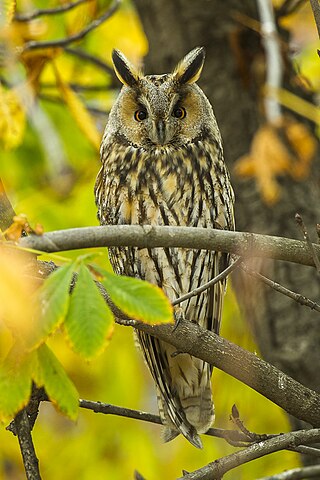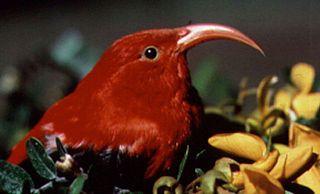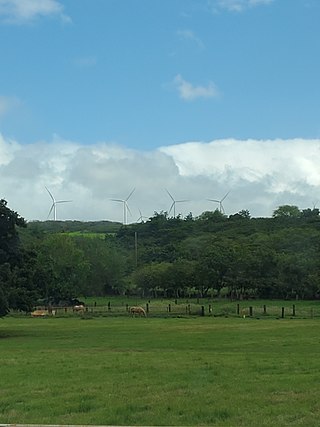
The ʻelepaio are three species of monarch flycatcher in the genus Chasiempis. They are endemic to the Hawaiian Islands, and were formerly considered conspecific. They measure 14 cm long and weigh 12–18 g. One species inhabits the Big Island, another Oʻahu and the third Kauaʻi. Being one of the most adaptable native birds of Hawaiʻi, no subspecies have yet become extinct, though two have become quite rare.

The short-eared owl is a widespread grassland species in the family Strigidae. Owls belonging to genus Asio are known as the eared owls, as they have tufts of feathers resembling mammalian ears. These "ear" tufts may or may not be visible. The short-eared owl will display its tufts when in a defensive pose, although its very short tufts are usually not visible. The short-eared owl is found in open country and grasslands.

The long-eared owl, also known as the northern long-eared owl or, more informally, as the lesser horned owl or cat owl, is a medium-sized species of owl with an extensive breeding range. The scientific name is from Latin. The genus name Asio is a type of eared owl, and otus also refers to a small, eared owl. The species breeds in many areas through Europe and the Palearctic, as well as in North America. This species is a part of the larger grouping of owls known as typical owls, of the family Strigidae, which contains most extant species of owl.
Located about 2300 miles (3680 km) from the nearest continental shore, the Hawaiian Islands are the most isolated group of islands on the planet. The plant and animal life of the Hawaiian archipelago is the result of early, very infrequent colonizations of arriving species and the slow evolution of those species—in isolation from the rest of the world's flora and fauna—over a period of at least 5 million years. As a consequence, Hawai'i is home to a large number of endemic species. The radiation of species described by Charles Darwin in the Galapagos Islands which was critical to the formulation of his theory of evolution is far exceeded in the more isolated Hawaiian Islands.

Asio is a genus of typical owls, or true owls, in the family Strigidae. This group has representatives over most of the planet, and the short-eared owl is one of the most widespread of all bird species, breeding in Europe, Asia, North and South America, the Caribbean, Hawaii and the Galápagos Islands. Its geographic range extends to all continents except Antarctica and Australia.

The Kauaʻi ʻōʻō or ʻōʻōʻāʻā was the last member of the ʻōʻō (Moho) genus within the Mohoidae family of birds from the islands of Hawaiʻi. The entire family is now extinct. It was previously regarded as a member of the Australo-Pacific honeyeaters.

The hoary bat is a species of bat in the vesper bat family, Vespertilionidae. It lives throughout most of North America.

The Hawaiian rail, Hawaiian spotted rail, or Hawaiian crake is an extinct species of diminutive rail that lived on Big Island of Hawaiʻi.

Moho is a genus of extinct birds in the Hawaiian bird family, Mohoidae, that were endemic to the Hawaiian Islands. Members of the genus are known as ʻōʻō in the Hawaiian language. Their plumage was generally striking glossy black; some species had yellowish axillary tufts and other black outer feathers. Most of these species became extinct by habitat loss, the introduction of mammalian predators, and by extensive hunting (their plumage was used for the creation of precious ʻaʻahu aliʻi and ʻahu ʻula for aliʻi. The Kauaʻi ʻōʻō was the last species of this genus to become extinct, likely a victim of avian malaria.

The Hawaiian hoary bat, also known as ʻōpeʻapeʻa, is a species of bat endemic to the islands of Hawaiʻi. The Hawaiian hoary bat occupies the major Hawaiian islands, making it the only extant and native terrestrial mammal in the islands. Some studies report that the mainland hoary bat lives in sympatry on the Hawaiian Islands alongside the Hawaiian hoary bat, although this is disputed. The Hawaiian hoary bat was officially named the state land mammal of Hawaiʻi in 2015. It is a federally listed endangered taxon of the United States.

The Oʻahu ʻamakihi is a species of Hawaiian honeycreeper in the family Fringillidae. The male is rich yellow below, sharply contrasted with greenish upper parts. Females are duller and have two prominent wing-bars. It has a total length of approximately 4.5 inches (11 cm). It is endemic to the island of Oʻahu in Hawaiʻi, and is likely the only surviving honeycreeper endemic to the island.

Hawaiian honeycreepers are a group of small birds endemic to Hawaiʻi. They are members of the finch family Fringillidae, closely related to the rosefinches (Carpodacus), but many species have evolved features unlike those present in any other finch. Their great morphological diversity is the result of adaptive radiation in an insular environment. Many have been driven to extinction since the first humans arrived in Hawaii, with extinctions increasing over the last two centuries following European discovery of the islands, with habitat destruction and especially invasive species being the main causes.
The wood harrier or mime harrier is an extinct bird of prey which lived in Hawaii during the Holocene. This small, short-winged harrier inhabited the forests of Molokai and Oahu where it presumably hunted for small birds and insects.

The Hawaiian hawk or ʻio is a raptor in the genus Buteo endemic to Hawaiʻi, currently restricted to the Big Island. The ʻio is one of two extant birds of prey that are native to Hawaiʻi, the other being the pueo and fossil evidence indicates that it inhabited the island of Hawaiʻi, Molokaʻi, Oʻahu, Maui and Kauaʻi at one time. Today, it is known to breed only on the Big Island, in stands of native ʻōhiʻa lehua trees. The species was protected as an endangered species in the United States, but was delisted in 2020. However, the IUCN classifies the species as Near Threatened.NatureServe considers the species Vulnerable.
Synemporion keana is an extinct species of bat which lived in what is now Hawaii from at least 320,000 years ago to around 2,100 years ago. It is the only species in the genus Synemporion.

The Crete Mediterranean forests is a terrestrial ecoregion that encompasses the Greek island of Crete.

Kawailoa Wind Farm is a wind farm near the Waimea Valley, on the North Shore of Oahu. Commissioned in 2011, it comprises 28 wind turbines. At maximum capacity the farm is able to produce 69 MW. Kawailoa Wind Farm has been operational since 2012 and is a part of Hawaii's renewable energy efforts. Despite its clean energy, there are unintended ecosystem impacts on some native species of birds and bats, and efforts to mitigate these threats are ongoing.















